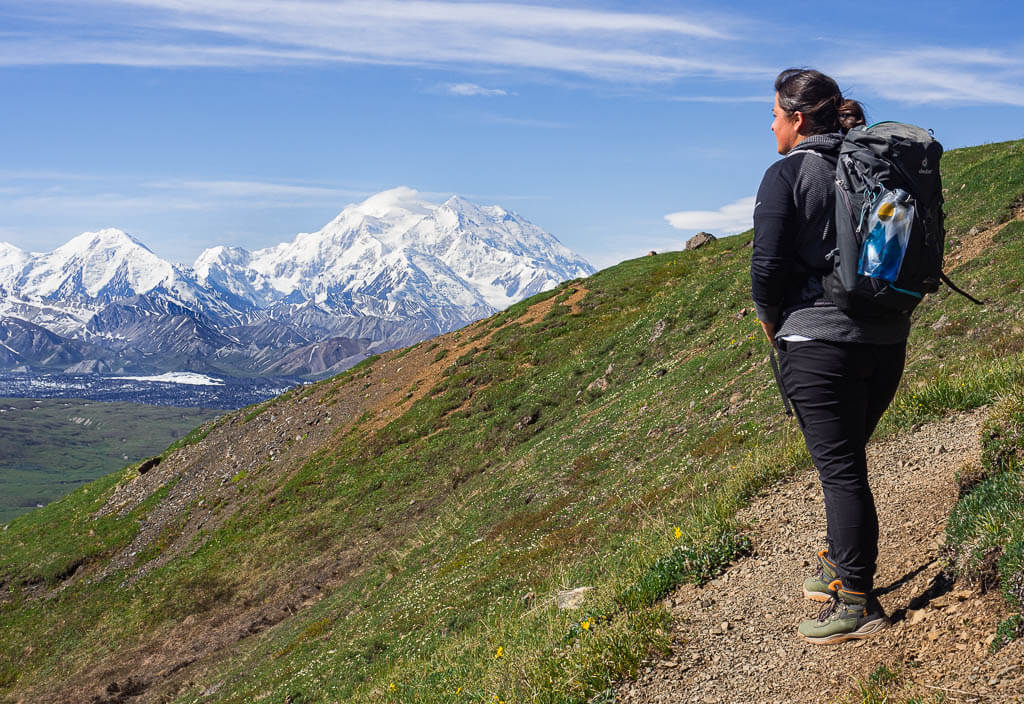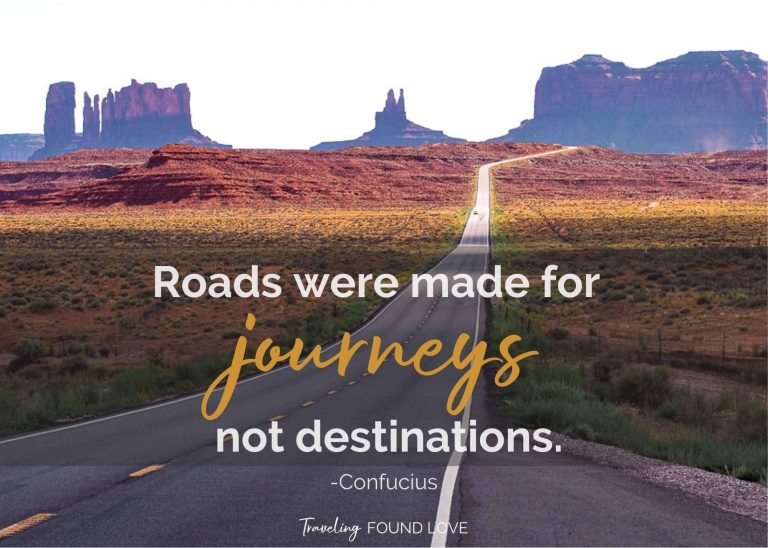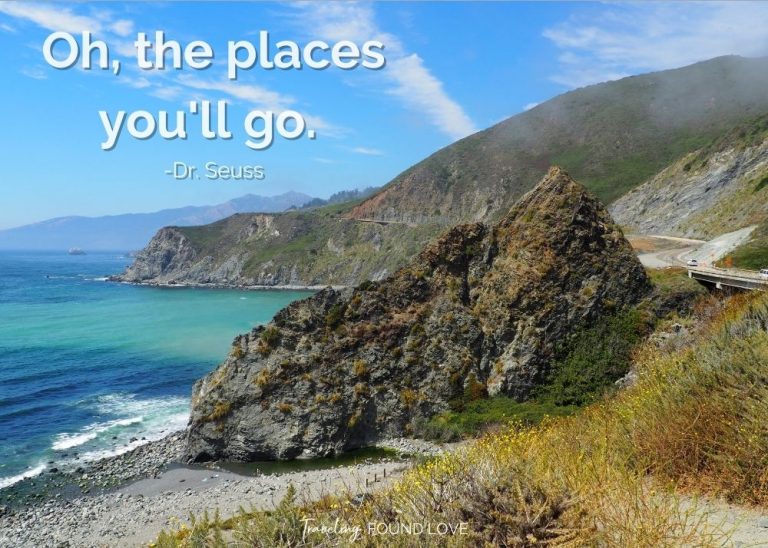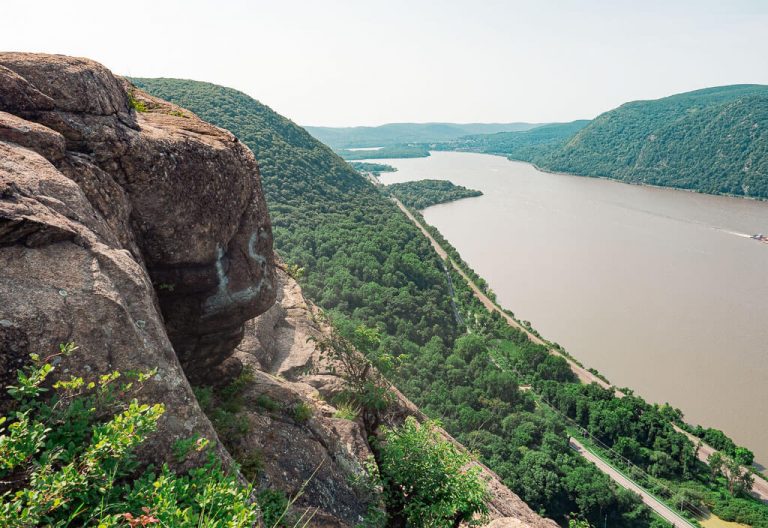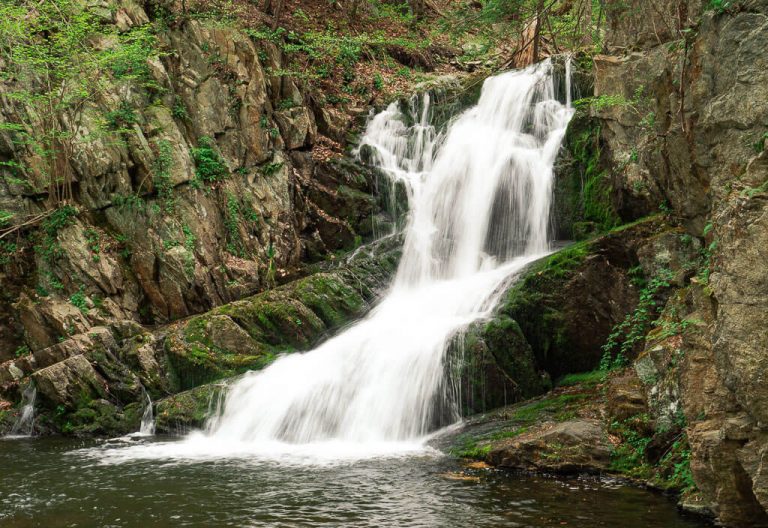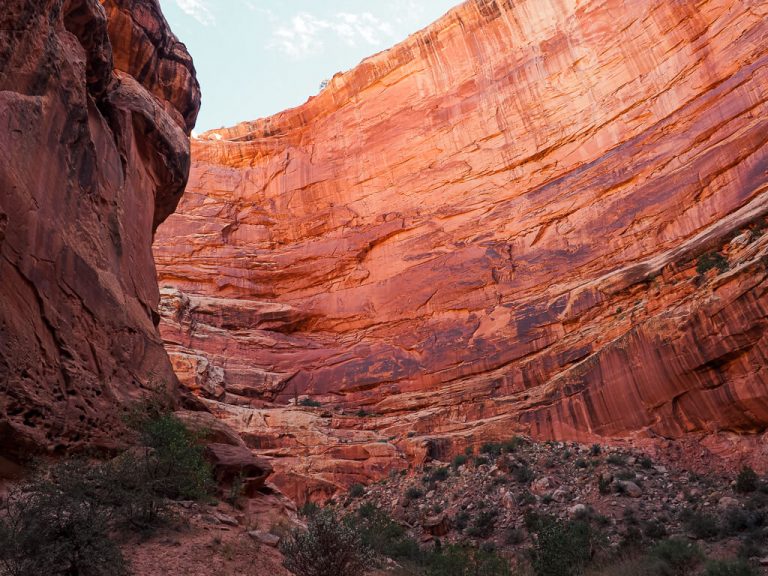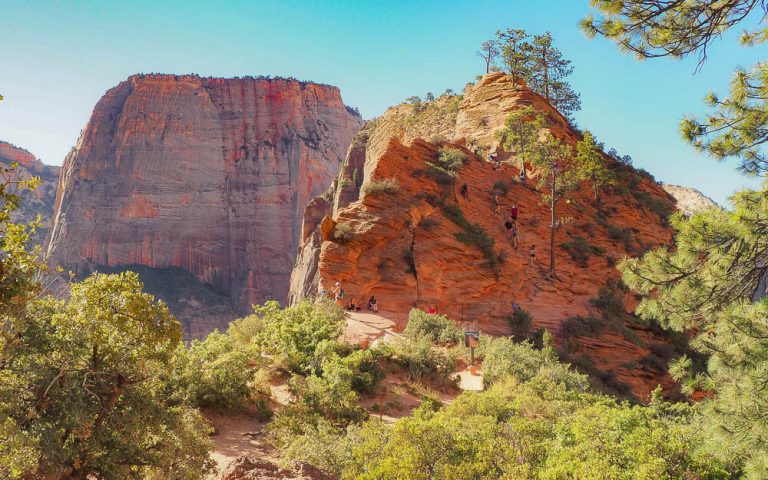What You Should be Packing for a Hike: The Essentials + Extras
The trails are calling your name. You are ready to explore the phenomenal landscape around you but there is one more thing you are unsure about. What should you be packing for a hike?
Not knowing what to pack for a day hike can be stressful but it doesn’t have to be. Even though no hike is the same, there are 10 hiking list essentials you should never forget. However, you may also want to put some personal items in your hikers pack or you may have to add some specific hike gear.
We hiked on hundreds of trails in the USA and the world. We found ourselves on rocky, dry terrain while hiking in Sedona, were wading through water to see the gorgeous Kanarra Falls, and felt like we were on top of the world on our hikes in New York.
It took us a while to figure out our ultimate packing for a hike list but we have finally created this complete day hike packing list to help get you ready for your hike as fast as possible. All the equipment for hiking we suggest below is gear for hiking we love and use.
This post may contain affiliate links. If you make a purchase through them, we get a small commission at no extra cost to you. It helps us create free content for you to enjoy. Learn more about our disclaimer here. Thanks for your support!
How to Choose a Day Hike Backpack
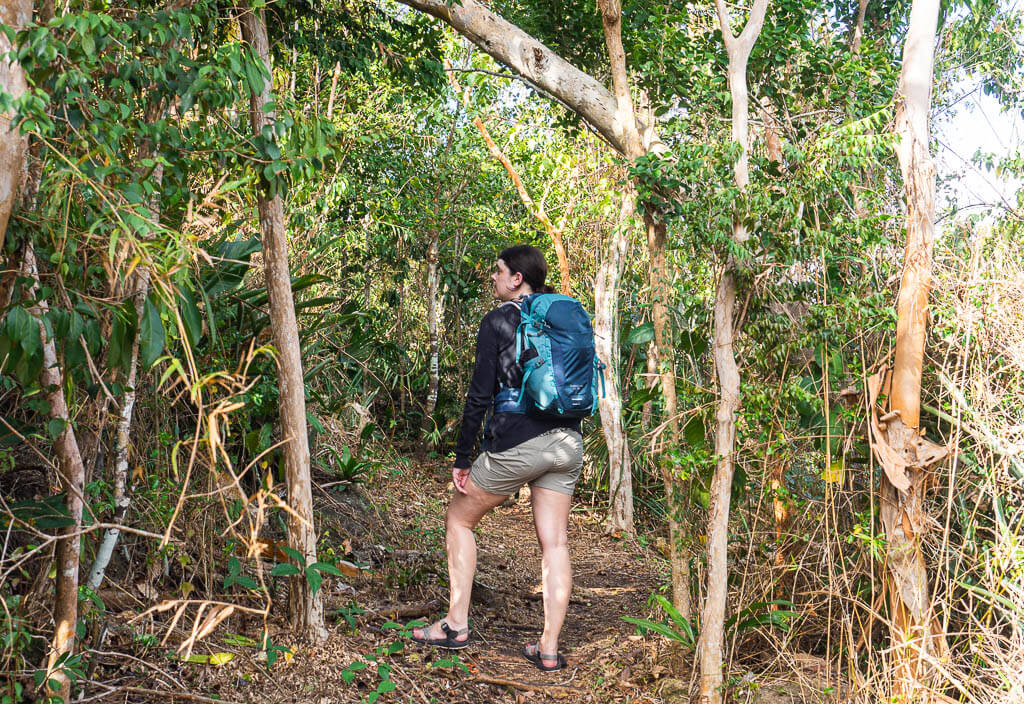
Before you can even start packing for a hike, you need to have the right backpack. But how do you know what kind of backpack is right for your hike?
Usually, a lot of beginners will utilize any backpack they have laying around their house. But once you start to really pursue hiking as a more frequent activity, it is time to invest in a decent hiking backpack. Trust us, having the right backpack will make a huge difference in your hiking enjoyment. Out of all the hiking gear, you could get, a good hiking backpack is the most important.
The most comfortable hikers pack is one that goes on your back. We would avoid buying a pack that is a crossbody. These bags do not distribute the weight evenly across your body.
After reading various reviews, trying on dozens of hikers packs, and even testing some on a short walk, we finally found our top pick.
We love the Deuter hiking backpacks because of their quality, versatility, design, and the Deuter Promise. Deuter promises to repair any damaged Deuter hikers pack for free, no matter how old your backpack is or what happened to it. Quite unique, right?
OUR PERSONAL FAVORITE BACKPACKS FROM DEUTER:
What Size Backpack will you need?
Which size backpack to pack for a hike is up to the difficulty and length of your hike and your preferences. All hikers packs will be measured in liters which accounts for the volume the bag can hold.
Most of the time, we enjoy moderate hikes between 4-8 miles. For all of our basic hiking equipment, and the photography gear (tripod, second lenses, batteries) we need one 20 liter backpack for the 2 of us. On hot days, we bring a smaller hikers pack (12 liters) to carry more water with us.
QUICK OVERVIEW OF WHICH SIZE TO BRING:
- Quick, easy, and casual hikes: 20 liters or less
- More moderate and lengthy hikes: 20 – 30 liters
- Longer backpacking hiking trips: 35 – 50 liters.
Which Features Do You Need?
There are so many high-quality backpacks that it can be super overwhelming to pick the right one. Make sure the brand you are considering produces a real hikers pack made for the outdoors. Those come with a lot of special features which make your hiking trip more enjoyable.
WHEN YOU LOOK FOR A BACKPACK, MAKE SURE IT HAS THE FOLLOWING FEATURES:
- (Adjustable) Hip belt
- Ventilated back
- Comfortable shoulder straps
- Side water bottle pockets
- Quick access outer pockets
- External straps and loops to hang items
- Bonus: An internal compartment for a hydration system
What Should you be Packing for a Hike?

Especially as a hiking beginner, it is difficult to know what to bring hiking. Below we have compiled a day hike pack list of everything that is suggested to pack for a hike. We start with the top 10 hiking list essentials for any hike and continue with hiking clothes, emergency kit gear, personal items, and optional hike gear for your packing list for day hike.
Some hiking supplies you find on the day hike packing list are non-negotiable while others you may be able to skip depending on the hike.
When you think about what to pack for hiking, you will soon realize how quickly the weight can add up and how much space is already gone. When looking for hiking gears, try to get lightweight and compact essentials for hiking.
We highly recommend doing your research before purchasing the right hike gear for you. Taking a few extra minutes and spending a few extra dollars on quality equipment for hiking will save you a lot of frustration out on the trails. Having the right hiking supplies can easily make or break a hiking experience.
10 Hiking List Essentials For Your Day Hike Packing List
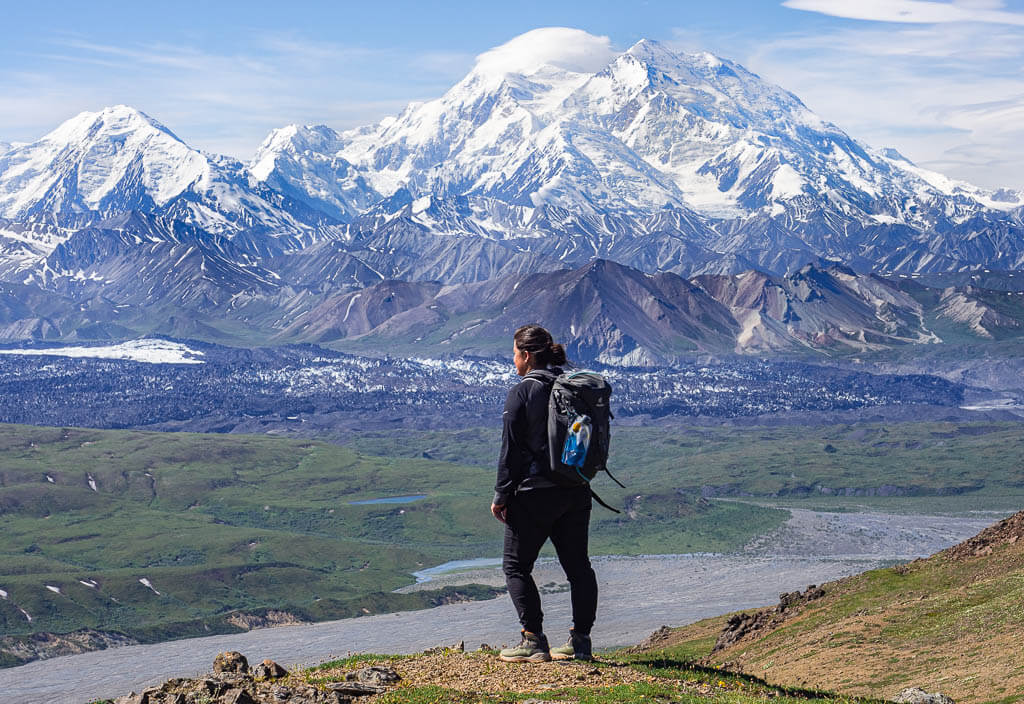
What to take on a hike are the top 10 hiking list essentials from the American Hiking Society. These items are the basic necessities needed for hiking.
HERE ARE THE 10 HIKING LIST ESSENTIALS:
- Appropriate Footwear
- Navigation – Map, Compass, GPS
- Food
- Water
- Rain Gear & Dry Fast Items
- First Aid Kit
- Safety Items – Light, Fire, Whistle
- Knife or Multi Tool
- Sun Protection
- Shelter
- Bonus: Trash Bag
Let’s talk about all of these non-negotiable essentials for hikers you should be packing for a hike more in-depth.
1. Appropriate & Comfortable Footwear to Pack for a Hike
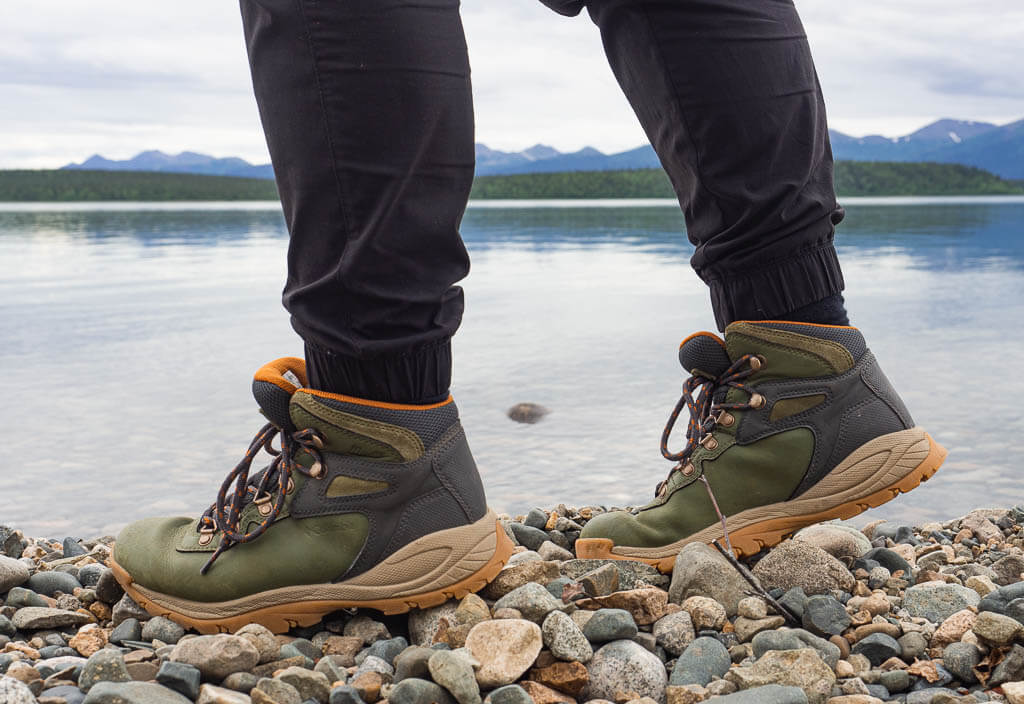
Having the right hiking footwear is crucial to put on your day hike pack list. Tired uncomfortable feet are no match for a hike. Keep your feet happy with the right footwear choices. You basically have three choices which footwear to pick, depending on the trail, its length, and the weather condition.
Top Tip: Whatever footwear you pick, make sure it is of good quality, broken in, and has a good thread.
- HIKING BOOTS
What to take hiking on rough or technical terrain are hiking boots. The over the ankle coverage prevents you from injuries like ankle sprains. Hiking boots also provide a stiffer midsole, which gives you more support. For about 90% of our hikes, we are utilizing hiking boots.
The Columbia Newton Ridge Plus is our go-to hiking boot. They are comfortable, lightweight, and affordable. You can’t go wrong with wearing a pair of these hiking boots on any trail.
Our Personal Favorite Hiking Boot: Columbia Newton Ridge Plus Hiking Boots
- HIKING SANDALS
When we walk on easy terrain, and dry conditions, we occasionally wear hiking sandals. Hiking sandals are a great choice for hikes that include water. However, they provide less support and stability than hiking boots.
A more convenient alternative to the popular Chaco hiking sandal is the Bedrock sandals. They are extremely durable, easily adjustable, lightweight, and comfortable. Not to forget the stylish design.
Our Personal Favorite Hiking Sandal: Bedrock Sandals
- TRAIL RUNNER SHOES
Trail runner shoes are the running shoes for the hiking world. They are a great option for your packing list for day hikes for hot summer days since your feet won’t sweat that much. Trail runner shoes are designed to be lightweight and more flexible than hiking boots. Their good outsoles come with maximum thread and grip, which makes them a great choice on rough terrain and even wet conditions.
We love the Hoka One One Speedgoat 4, a super lightweight, well-cushioned trail runner. Due to the higher height, your feet get more support and stay in place even on steep inclines.
Our Personal Favorite Trail Runner Shoes: Hoka One One Speedgoat 4
2. Navigation – GPS, Map, Compass
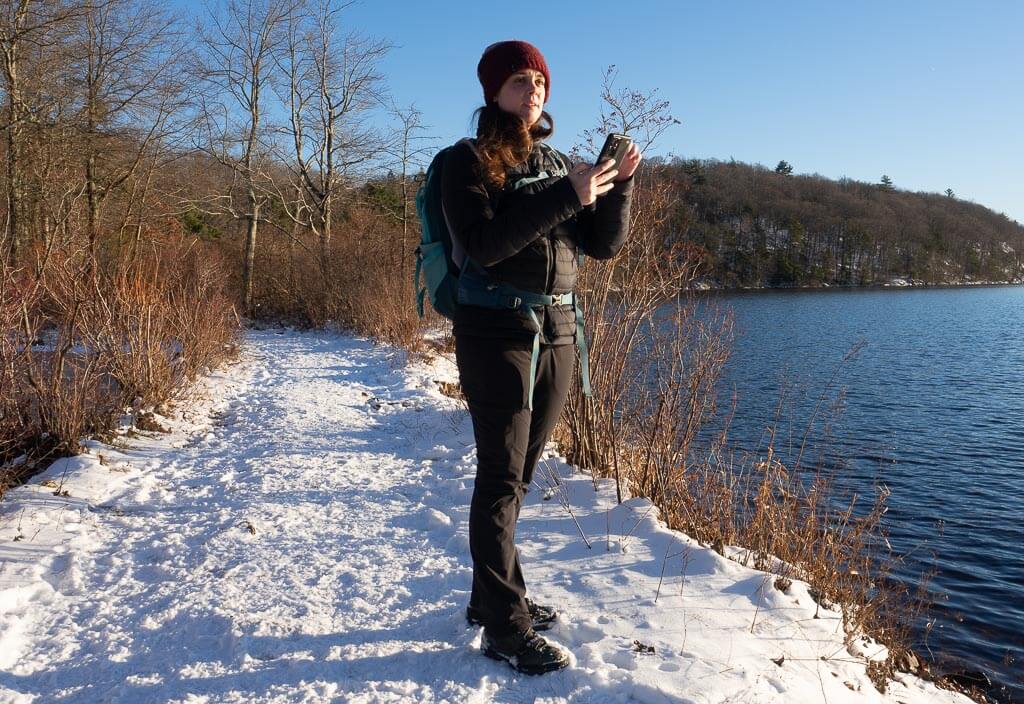
There are different options for what to take on a hike to navigate yourself on the trail. Although paper maps are the most trusted navigation on the trails, a digital map is more favorable for most of us.
- GPS
GPS is one of the hiking list essentials. But let’s be honest, for most of the hikes it will be sufficient to use your phone for GPS. There are a lot of great hiking apps out there which will provide you with (offline) trail maps, and other special features which will brighten up your hiking experience.
For almost every hike we use the AllTrails App. With the AllTrails Pro version, you can download digital maps of the trail beforehand so you can follow along with your location on the trail.
For more experienced, avid hikers, you may want to think about investing in a GPS device such as the Garmin InReach to navigate and communicate while out in the woods.
- PAPER MAPS
Call it old-fashioned but paper maps still come in handy when you are out in the woods. We know we all prefer technology but what happens when that fails?! You need a backup. Slip a paper trail map in the back of your hikers pack just in case. In State Parks or National Parks, you can usually find those at the park’s office or even at the trailhead.
When we can’t find a paper map of the trail, we will snap a photo of the trail map posted at the trailhead.
- COMPASS
Another inexpensive navigational tool for adventurous hikers would be a classic compass. It is always good to carry one with you to make sure you know the direction you are heading to. Learn the basics of how to use a compass before you hit the trails.
3. Food
What to bring on a hike is water but also nutritious food. Besides staying hydrated, you need to stay energized. No matter the hike, always carry some type of food with you. You never know what the trail brings.
Just like water, the longer the hike, the more food you should pack for hiking. We usually always have a couple of easy and healthy snacks in our backpacks like granola and energy bars, dried fruit, and nuts.
4. Water
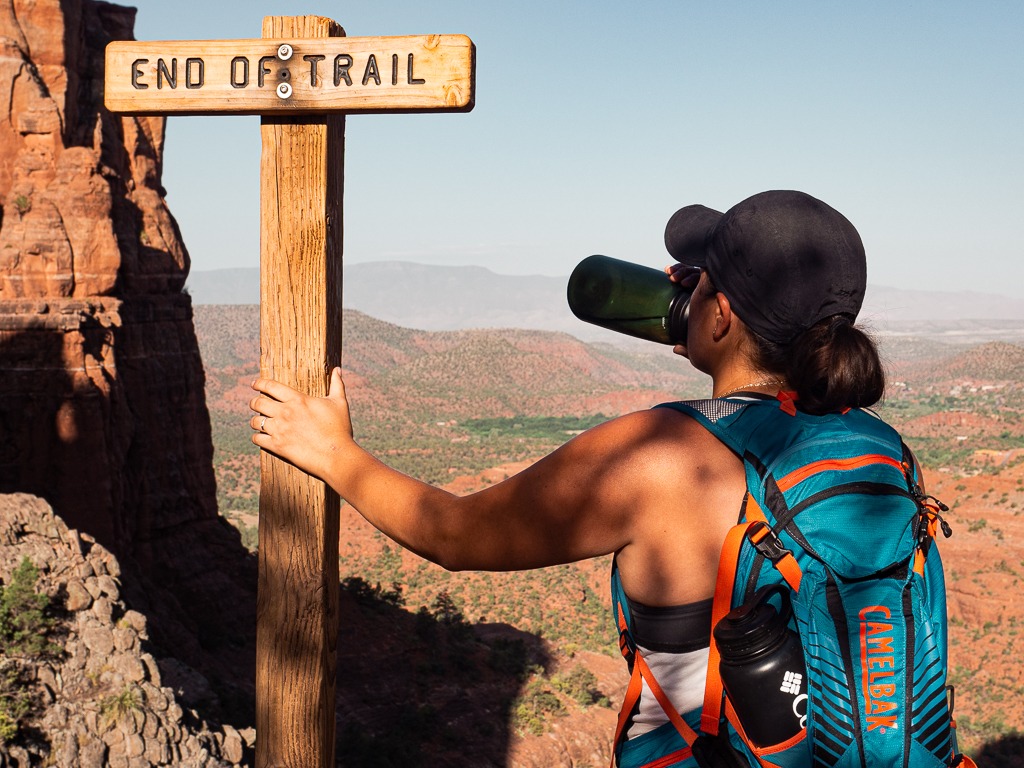
There is no question that water is a must when packing for a hike. Staying hydrated is essential for all outdoor activities.
According to the Hydration Basics, a general guideline for water is to have at least a half-liter for each hour of moderate hiking in moderate temperatures. The more strenuous the hike and the hotter the temperatures, the more water you will need to pack for a hike.
- INSULATED WATER BOTTLES
There is nothing better than drinking a cool sip of water on a hot summer day. Put the insulated Hydro Flask bottle on your checklist for hiking to keep your water cool and refreshing.
- HYDRATION BLADDER
If you are tired of fighting trying to get your water bottle out of your backpack whenever you want a drink, utilize a hydration bladder for quick access and to keep your hands free.
- WATER FILTRATION SYSTEM
Especially for long hikes or backpacking trips with safe water sources around, a compact water filtration system is our top pick for the day hiking packing list. It keeps your hikers pack lighter and eliminates the worry of running out of water.
- COLLAPSIBLE WATER BOTTLE
Have limited space in your hikers pack? Carry an extra collapsible water bottle like the Platypus soft bottle.
5. Rain Gear & Dry Fast Items
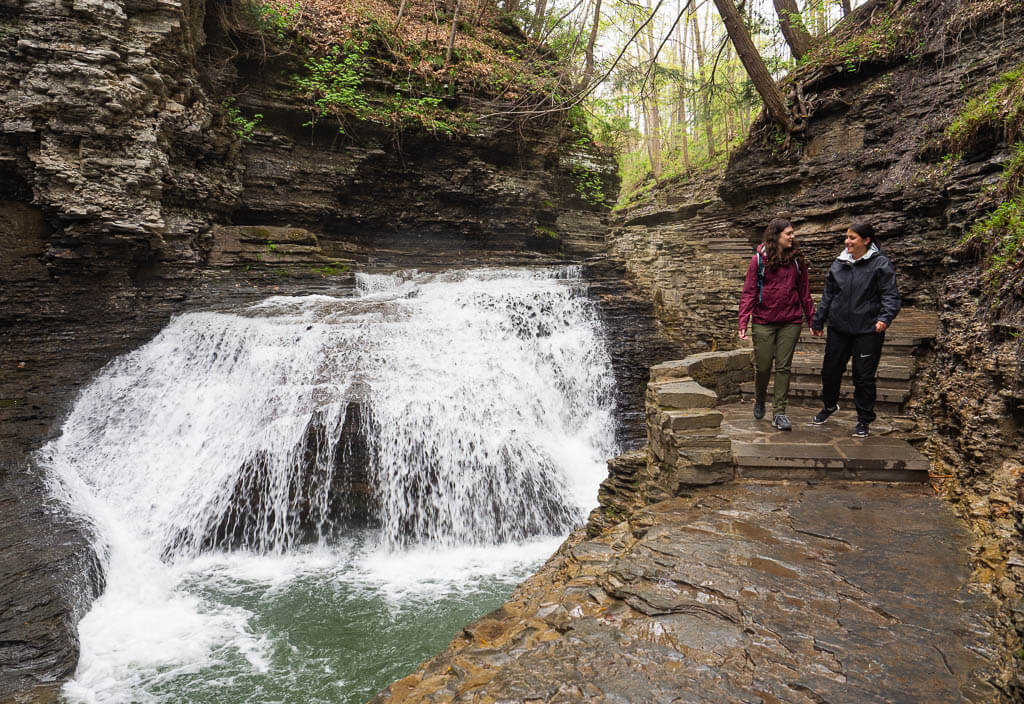
- RAINCOAT
When hiking, packing a raincoat for your hike can have multiple functions. First, it helps you stay dry when a (un)expected rain shower passes through. Second, it helps to break the wind at the summits, when climbing a mountain.
When searching for a raincoat for your day hike pack list, look for one that is waterproof, breathable, and folds up small and tight. We would highly suggest spending the extra money on a quality waterproof coat.
Our Personal Favorite: North Face Rain Coat
Top Tip: We will talk more about other rain hike gear below.
- BREATHABLE, DRY FAST CLOTHES
Expect to sweat a lot on your outdoor adventures, so sweat-absorbing shirts, long sleeves, and pants are essentials for hiking.
We would recommend clothes out of polyester or nylon. All of these materials move your sweat away from your skin and dry quickly. Also, make sure you can move freely in your clothes since you will have to be flexible on your hikes.
6. First Aid Kit
Hiking and exploring the outdoors can sometimes lead to unexpected injuries. That is why it is important that you are fully equipped to handle basic cuts and swellings. A basic First Aid Kit on your day hike packing list will keep you prepared for those unwanted mishaps.
Top Tip: Make sure you have blister care treatments from bandaids to ointment in your first aid kit. Blister bandaids have saved our lives a couple of times, especially when we were on multi-day hike adventures.
7. Safety Items – Light, Fire, Whistle
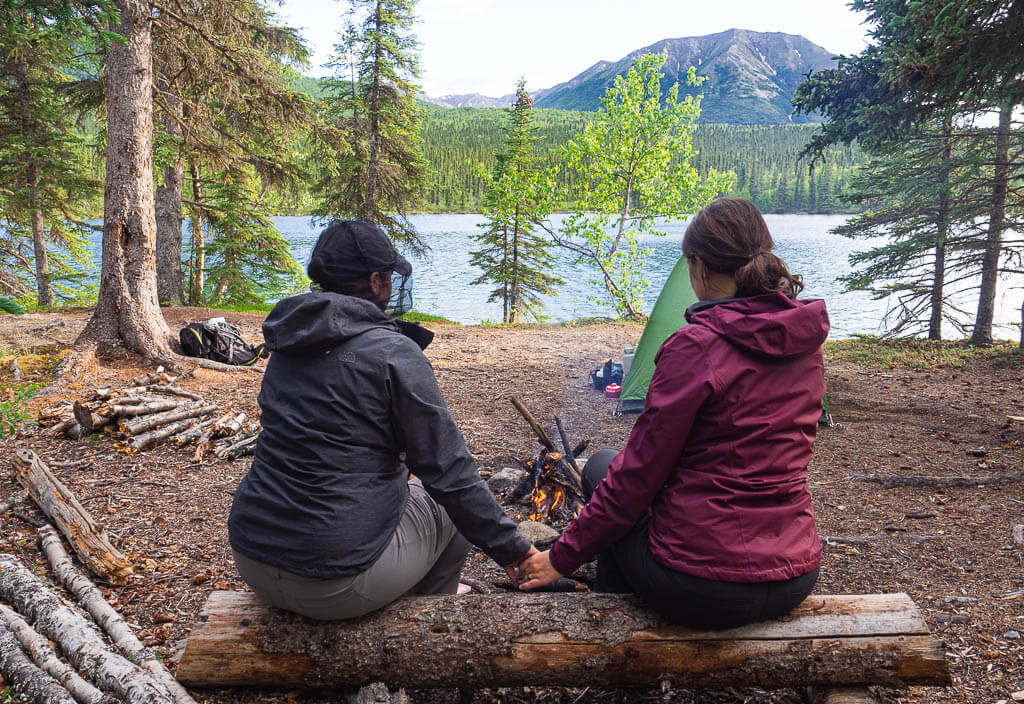
Safety should be a top priority when you hit the trails. In case of an emergency you want to be prepared with the following essentials for a hike:
- HEADLAMP OR FLASHLIGHT
No matter the time of day you are packing for a hike, make sure you have some type of illumination device with you. The optimal things to bring on a hike are the Black Diamond Headlamp or a water-resistant flashlight. We would always opt for the headlamp since it is a hands-free device.
One obvious thing you need to make sure of before heading out is that your headlamp or flashlight is stocked with batteries that work.
- FIRE
When you are packing for hiking, you can choose to put a fire starter, waterproof matches, or a compact lighter in your hikers pack. All these essentials for hikers are lightweight and easily packable.
Hopefully, they will just stay in your backpack unless you actually plan on using them to stay a night outdoors.
- WHISTLE
A basic whistle in your pack for day hike is actually handier than you think. You can use it if you find yourself lost from your group or for emergencies wildlife encounters.
Top Tip: Some bigger hikers packs already have whistles included on their chest strap buckles. Their quality is not the best but it is a start.
8. Knife or Multi Tool
A knife or multi-tool should definitely be on your hiking essentials list. You never know when you will need a knife, like this Swiss Army Knife, or another multi-tool on the trails. We have actually utilized our multi-tool more than we thought for various occasions, especially on backpacking trips.
Besides these tools, another essential repair item you may want to carry is duct tape. Duct tape can easily and quickly repair most essentials for a hike for the time being.
9. Sun Protection on the Trails

Protecting yourself from the sun is super important when you are spending the day outdoors. You can do this by easily applying sunscreen before heading out the trails, applying SPF chapstick on your lips, and wearing a hat and sunglasses.
- SUNSCREEN
Especially on those non-shaded hikes, sunscreen is what to pack for a day hike. Add it to your day hiking packing list and reapply it throughout the hike. We always carry a travel-sized sunscreen with us in our first aid kit.
- SUNGLASSES
When packing for a hike, don’t forget sunglasses. The best-polarized sunglasses brands for outdoor adventures are Goodr or SunGod. SunGod is a tad bit more pricey whereas Goodr is a great budget option.
10. Emergency Shelter
Hopefully, this is one of those 10 hiking list essentials you will never have to worry about using while enjoying the numerous hiking trails throughout the world. But an emergency shelter is one of the things to bring on a hike to have handy when the time comes.
An emergency shelter can also be used as a blanket or sleeping bag to keep you warm and help you survive until you can get rescued.
Bonus: Trash Bag
What to pack for hiking to practice the Leave No Trace Principles is a small trash bag to bring out all trash. Simply find a small crevice in your backpack and throw it in.
We are frequently shocked about the trash we find along the beautiful hiking trails in New York. To keep nature beautiful, also help by picking up other trash you see along the way.
Anytime you go out on a hike it is good practice to let someone know the details about your hike. Don’t forget to share an estimated time you expect to be back. This is especially important for more remote hikes.
Cairns is a great safety app for your phone which lets your friends see your location and makes it easy to share important information about your hike. In case of an emergency, there will be someone who can help you immediately.
Hiking Clothes
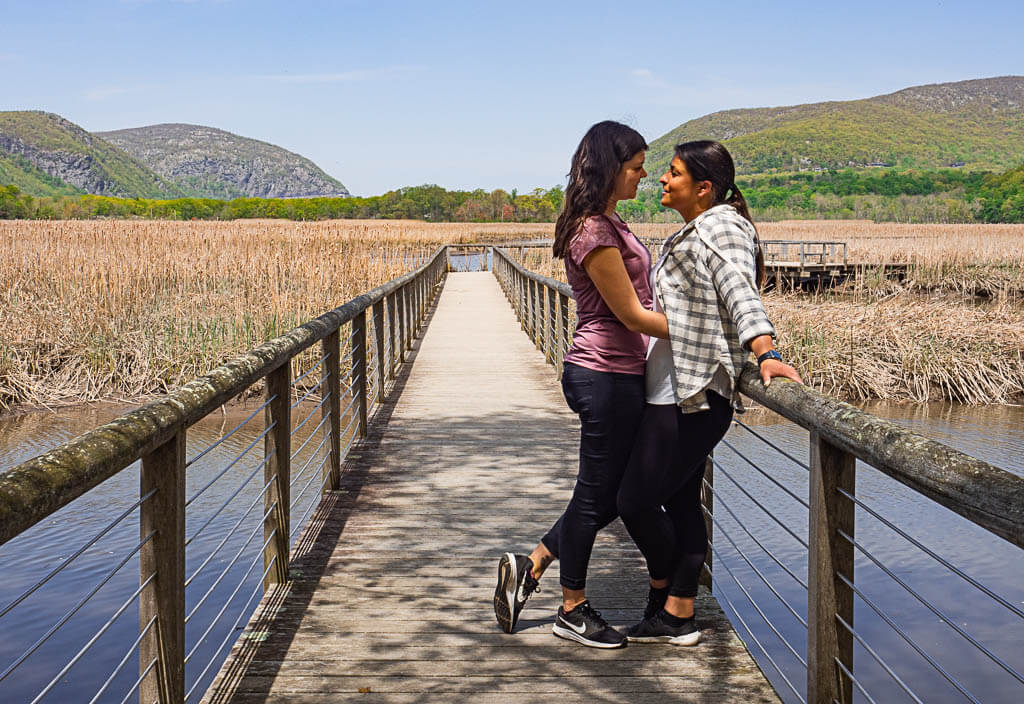
After packing for a day hike, including all the 10 hiking list essentials, it is time to think about what to wear on the trails.
Especially hiking beginners, they hit the trails in whatever they can find in their closets. That might work in the beginning but if you really want to get into hiking, you should think about investing in clothing specific for hiking.
You will want to wear hiking clothes that are comfortable, durable, breathable, and weather appropriate. Avoid wearing heavy cotton, and denim clothing.
Hiking Pants
There is a wide variety of hiking pants out there. You could go crazy trying to find the best hiking pants and spend hundreds of dollars. But it doesn’t have to be that complicated and expensive.
Our go-to affordable, comfortable hiking pants are Outdoor Research Ferrosi pants. They are lightweight, durable, stretchy, and have a waterproof softshell which makes them ideal for a variety of outdoor activities.
Our Personal Favorite: Outdoor Research Ferrosi Pants
Hiking Socks
Don’t forget to put hiking socks on your list of hiking gear. Good hiking socks with a thick cushion make a huge difference in how your feet will feel after any hike. If we are on the trails, we are hands down wearing a pair of Darn Tough hiking socks.
Our Personal Favorite: Darn Tough hiking socks
Extra Layers
No matter when or where you are hiking, it is essential to carry layers with you. There have been many times we have either started a hike off cold before the sun warmed us up or vice versa. When you climb a mountain, you might also get chilly without a second layer due to the wind.
We are in favor of putting an extra layer in our backpacks when we pack for hiking. Our go-to layers are either a lightweight pullover or a fleece jacket.
Our Personal Favorite: REI Trailsmith Fleece Jacket
Seasonal Hiking Clothes to Pack for a Hike
Depending on the season you go on a hike, the weather can be more extreme. To adapt to the trail condition and to be safe, you need these extra hiking supplies on your hiking essentials list:
Packing for a Hike: Cold Weather
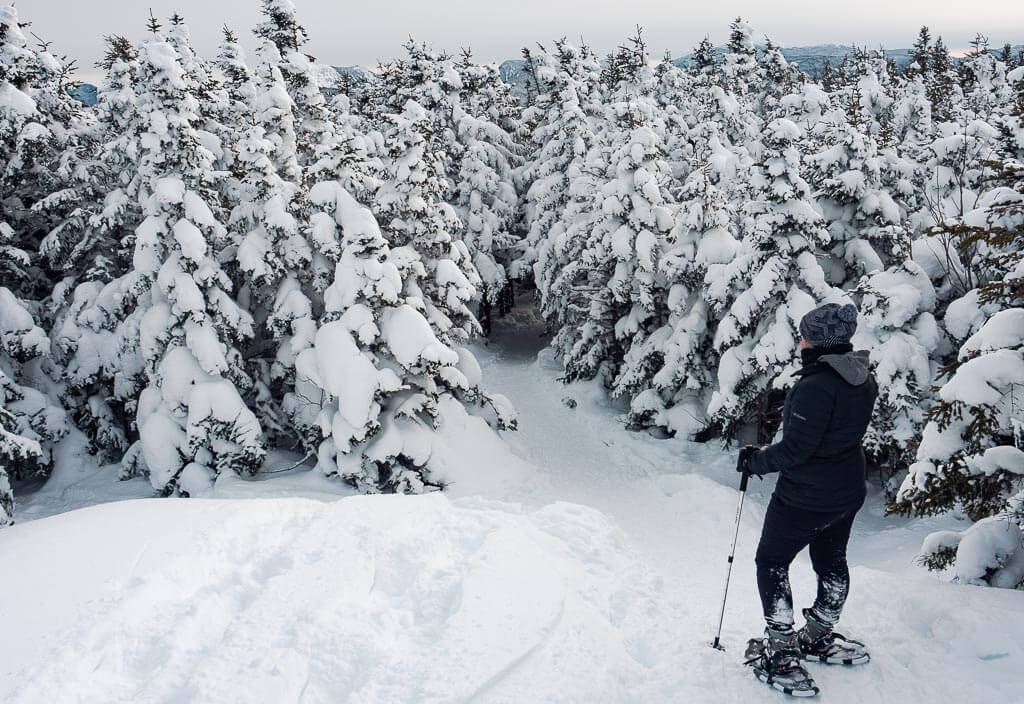
The cold requires some specific hiking supplies you should pack for a hike to make the most out of your trip.
Insulated Jacket
We already talked about the benefits of wearing layers. For the cold weather, you have to top it off with a dependable insulated jacket.
Finding the right jacket for you can be overwhelming and expensive with the huge variety of styles, brands, and designs. We found this jacket from Columbia to be our perfect match for winter hiking and other winter outdoor activities. It has the best fit and price for our budget.
Our Personal Favorite: Columbia White Out II
Hardshell Pants
A pair of hardshell pants are the best way to protect your legs from the elements. These REI Co-op Activator 3.0 pants are completely waterproof and durable to keep you warm and dry through your entire hike no matter the weather.
Base Layers
Quality base layers are super, super important to pack for a hike in the cold. They make a world of difference between enjoying a winter hike and completely hating them because you can’t stop freezing.
For the cold weather, what to bring on a hike are merino wool base layers. We recommend these Odlo thermo layers.
Our Personal Favorite: Odlo
Warm Hat
A hat is always something useful to pack for a hike, no matter the weather. But for colder weather, you are going to need something a little more. We prefer to wear a winter hat that has some fluffy lining to keep our heads warm.
Gloves
Gloves are a must on your packing list for day hikes, when exploring in the cold weather. It is best to try and use gloves that are touchscreen-friendly, meaning they are equipped with e-tips. That allows you to use your device, like phones or cameras, while still wearing your gloves.
For moderate cold temperatures, we like to use our North Face Etip glove. But for extremely cold weather you are going to need something a bit more insulated, like these Outdoor Research or Black Diamond gloves.
Buff
A buff is an ideal accessory for a hiker because of its versatility. Buffs can be worn in a multitude of ways including as a bandana, headband, or scarf. We personally love to wear a buff around our necks when we go hiking in cold weather to keep every inch of our body warm.
Mircospikes / Crampons
Microspikes are best used on flatter icy or packed snow hiking trails. This specifically designed equipment consists of chains and small spikes which easily slip over your hiking boots to help with traction.
Our Personal Favorite: Yaktrax microspikes
Crampons should be worn on icy sloped hiking trails or for climbing. This foot traction system also slips over your hiking boots but with bigger spikes. Hiking crampons are usually lighter in weight with shorter spikes, whereas climbing crampons are heavier with longer spikes for optimal traction.
Our Personal Favorite: Outdoor 360 crampon
Snowshoes
When you are packing for a hike in the winter, snowshoes are a must for powdery and deep snow trails. When picking out snowshoes, keep in mind that the heavier you are (including your hikers pack) and the deeper the snow, the longer and wider the snowshoes need to be.
On the flip side, the smaller and narrow frames are best for packed snow which you usually find on well-traveled winter hiking trails.
Top Tip: If you only want to go snowshoeing occasionally in tourist areas, you can also rent snowshoes from a local retailer.
Packing for a Hike: Hot Weather
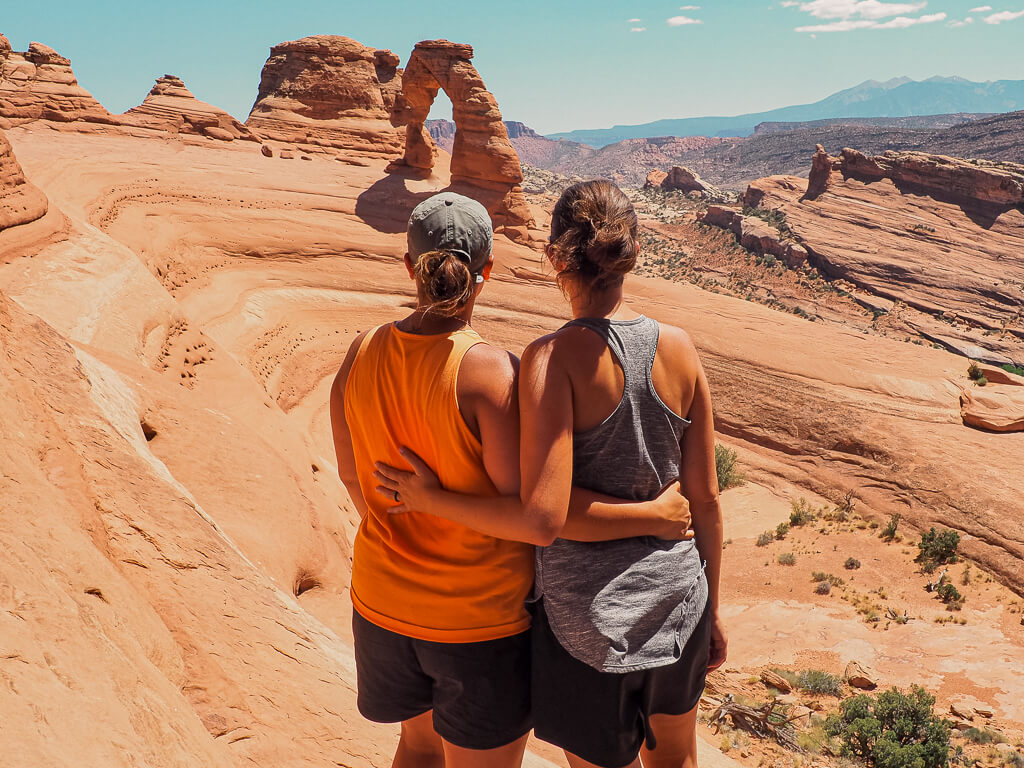
What to bring hiking really depends on the weather. When we hike in the hot season, we always try to hit the trails in the early morning or the evening to avoid the hot sun beating on us.
You should dress accordingly to adapt to the weather conditions as much as possible. These essentials for hiking should be on your checklist for hiking in hot weather:
Hiking Shorts
For our warmer weather hikes, we prefer to wear a pair of comfortable hiking shorts. Just like our regular hiking pants, you want your hiking shorts to be lightweight, breathable, durable, and stretchy for maximum comfort while hiking.
There are a couple of good brands out there to put on your hiking essentials list, but we absolutely love our Columbia hiking shorts which meet all of the listed requirements and come in a few stylish colors.
Hiking Tops
When picking out hiking tops to pack for a hike, we suggest choosing tops that are made from polyester or nylon. These materials move your sweat away from your skin and dry quickly. Also, make sure you can move freely in your top since you will have to be flexible on your hikes.
Sun Hat
A hat is what to pack for a day hike to protect your head and your face from the sun. You can easily wear an ordinary baseball hat or a wide-brimmed sun hat for more protection.
Packing for a hike: Rainy Season
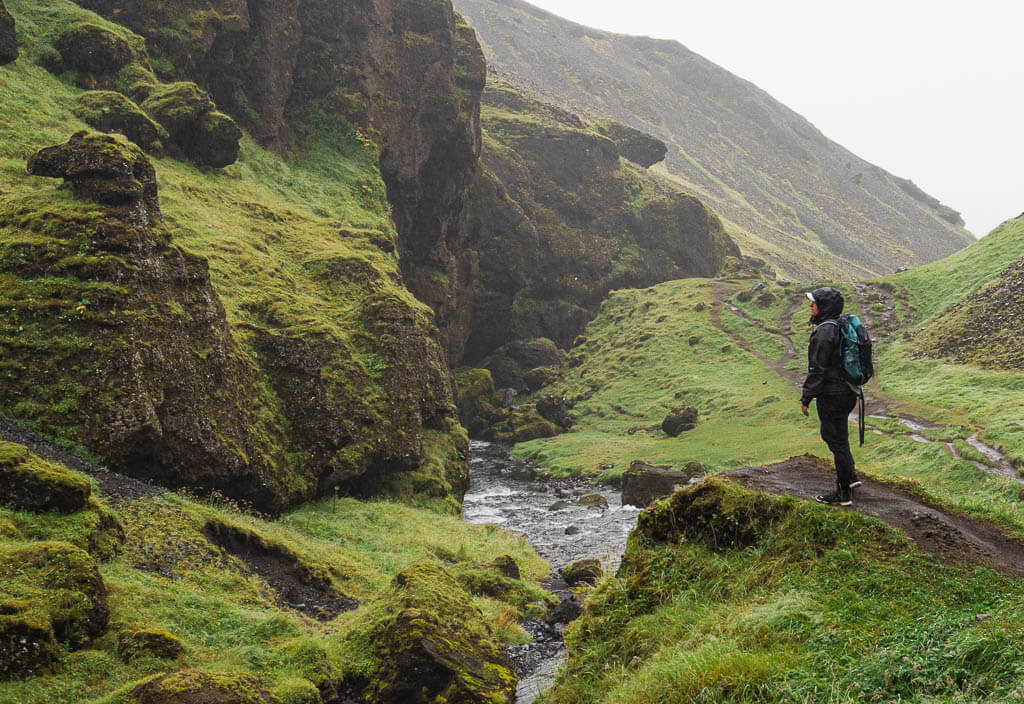
Rain gear should be one of the top 10 hiking list essentials when it comes to packing for a hike. We have already mentioned a raincoat which is one of the things to bring on a hike for (un)expected rain but also as a windbreaker. Here is some other essentials hiking you should consider packing for a hike:
Rain Pants
If you happen to be hiking in an area where it rains quite frequently, what to take hiking is a pair of rain pants. On our trip to Alaska, they came in quite handy when enjoying outdoor adventures on rainy days.
Our Personal Favorite: REI Rainier Full Zip Rain Pants
Hiking Gaiters
At first, we didn’t have gaiters on our hiking list of gear, but we quickly had to change that. Hiking gaiters are great to keep trail debris, water, and snow from getting inside your hiking boots. For us, these would be an optional piece of hike gear in the rain or snow.
Our Personal Favorite: Outdoor Research
Rain Cover for Hikers Packs
Some packs, especially bigger backpacks, already come equipped with a rain cover. But if for some reason your hikers pack does not have one, it is an inexpensive piece of equipment to add to your list of hiking gears that can be a huge stress relief. It will simply keep your gadgets and equipment for hiking dry.
Emergency Kit
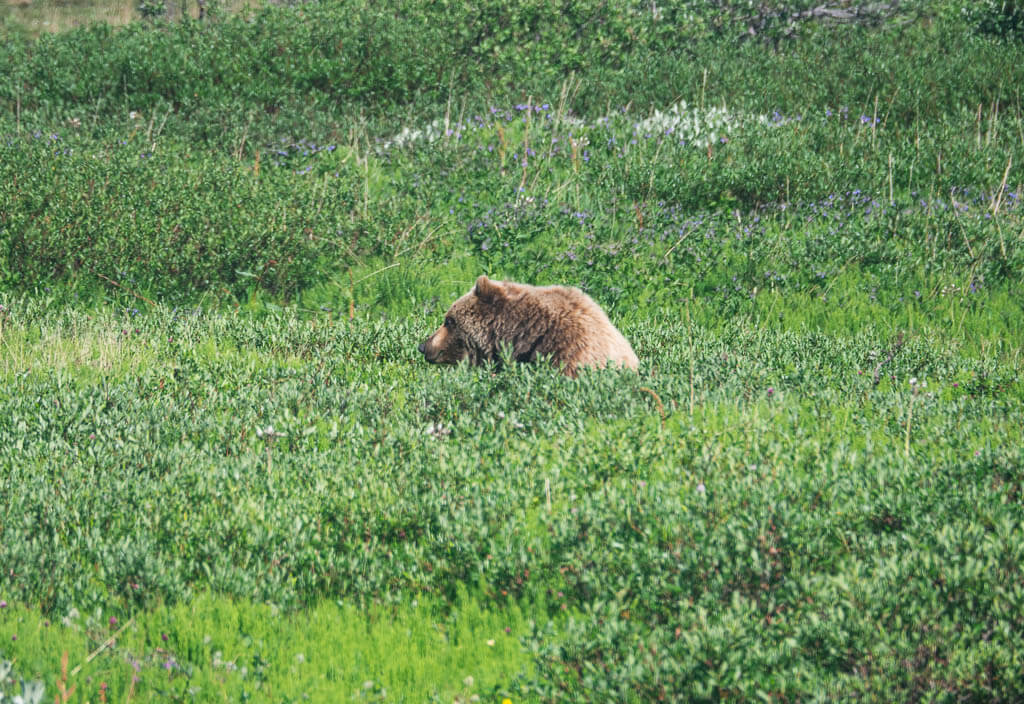
We already mentioned putting the most important emergency hiking supplies, like a first-aid kit, headlamp, pocket knife, and emergency shelter on your checklist for hiking. There are still some essentials for hikers left you should add to your emergency kit.
Insect Repellent
Mosquitos could quite possibly be the most annoying insects, especially during certain times of the year. If you do not want to continuously swat away those little bloodsuckers, when packing for a day hike, it is a good idea to bring a small travel-sized bug spray with you in your hikers pack.
Emergency Paracord Bracelet
We recently added an emergency paracord bracelet to our packing for a hike list. With its whistle, it is super functional for possible bear encounters on our hikes in upstate New York. This multifunction bracelet can also be used as a compass, to tie up hiking supplies, assist in creating a shelter, and starting a fire. We now hang our emergency paracord bracelet from our Deuter backpack.
Bear Spray
Don’t know what to pack for a day hike in bear country? You will definitely want to have a can of bear spray on your checklist for hiking. Bear spray is a specifically designed spray that is used as a last resort to protect yourself from bears. Always keep it handy, so that you can reach it immediately when there is a bear encounter.
So far we have not had to use our can of bear spray and we hope we never have to. If you are planning a hiking trip in certain National Parks in the United States, bear spray is one of the essentials for hiking and will calm your nerves on the trails.
Hand Sanatizer
It isn’t always easy to wash your hands outdoors. When packing for a hike, don’t forget to put a travel-size hand sanitizer in every hiker pack.
Medications
When you pack for day hikes, don’t forget to put certain personal prescribed medications in your backpack, besides bringing basic medication like ibuprofen (or whatever pain reliever you prefer) in your first aid kit.
Personal Items
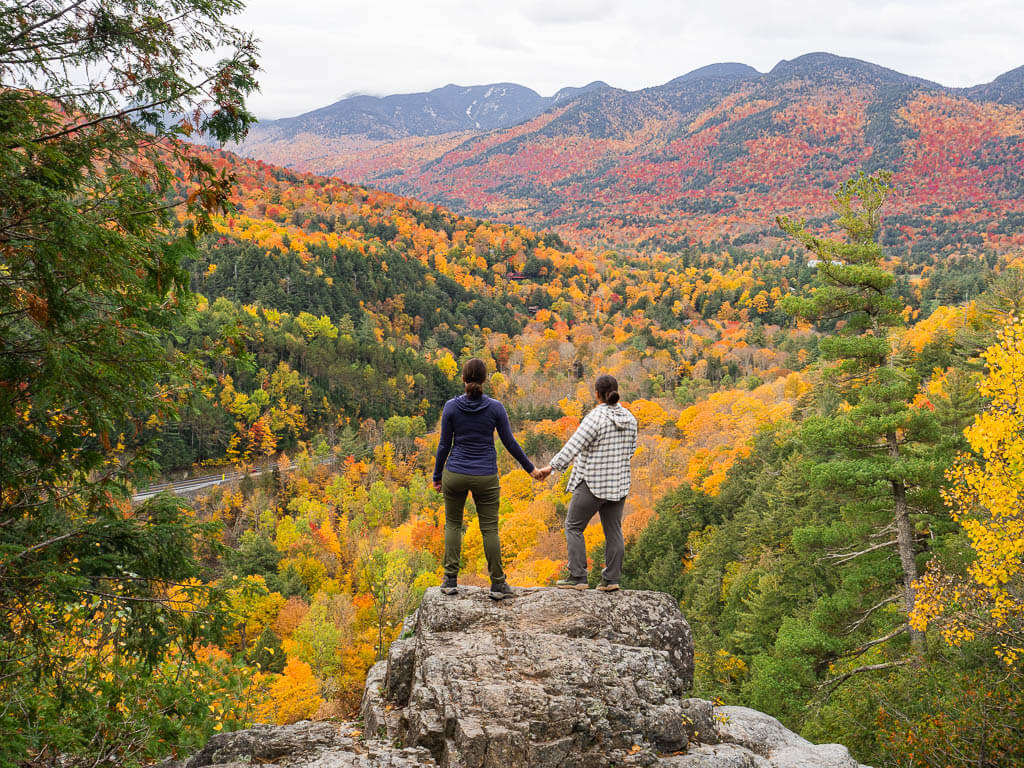
There are some personal hiking supplies you should be packing for a hike. In case of an emergency, they might help you out a lot. Always have these documents and items in your backpack:
- Cash / Credit Cards
- Identification Card
- Phone
Photography Gear
We could not imagine going on a hike without our photography gear. It is on top of our day hike pack list. On the trails, there are so many beautiful panorama vistas and wildlife encounters we want to capture. Your phone is an okay option to do so but nothing can beat a real camera with all its specific features.
HERE IS A QUICK LOOK AT WHICH CAMERA GEAR YOU CAN FIND IN OUR HIKERS PACK:
Camera (+ Lenses)
Honestly, there are a lot of great photography brands out there which makes it difficult to choose which one is right for you. Before getting into too many details, you have to figure out which type of photography you are looking for. We usually use a high-quality mirrorless camera. It is great for traveling since it is lightweight and small, and you can switch out the lenses for your different photography purposes.
After deciding which type you prefer, try to test different cameras before you actually buy them to figure out which camera handling and its features attract you the most.
Our Personal Favorite: Olympus Mark ii
Action Cam
Besides snapping awesome photos, you can also make videos to capture amazing memories from your hike. GoPro Hero is a real game-changer with its high quality, compact design, versatility, and durability. GoPro also has cool accessories to purchase to make videoing your adventures even easier.
Our Personal Favorite: GoPro Hero
Tripod
Tripods are great for pictures that require more stability or for getting the photographer in the photo. When searching for a tripod to pack for a hike, look for a lightweight compact design.
Our Personal Favorite: Rollei travel tripod, Peak Design travel tripod
Camera Remote
Snap unlimited clear photos hands-free with a camera remote. You don’t have to buy a remote from your camera’s brand, almost any camera remote will do as long as it is compatible with your camera. We use our camera remote on every hike we take to capture us in front of the beautiful landscapes.
Camera Cleaning Kit
Keep your camera clean wherever you go with a cleaning kit. When using your camera outdoors, unwanted dirt can appear quickly on your camera. Avoid having nasty dirt or water spots on your photos with this simple solution.
Capture Clip
We didn’t know what we were missing out on before we found the innovative Peak Design Capture Clip camera accessory. The clip easily and quickly mounts your camera or GoPro right to your hikers pack strap. No annoying camera strap dangling around your neck anymore.
Journal
Besides capturing the beauty of hiking on camera, we also like to put it into words in a journal.
It is not one of the things to bring on a hike unless it is a multi-day hike. Since we prefer not to waste paper, we found this Rocketbook Journal much more eco-friendly. You are able to write down your thoughts, upload the pages on a cloud, wipe the pages clean, and start all over again and again.
More Useful Hike Gear to Add to Your Day Hike Packing List
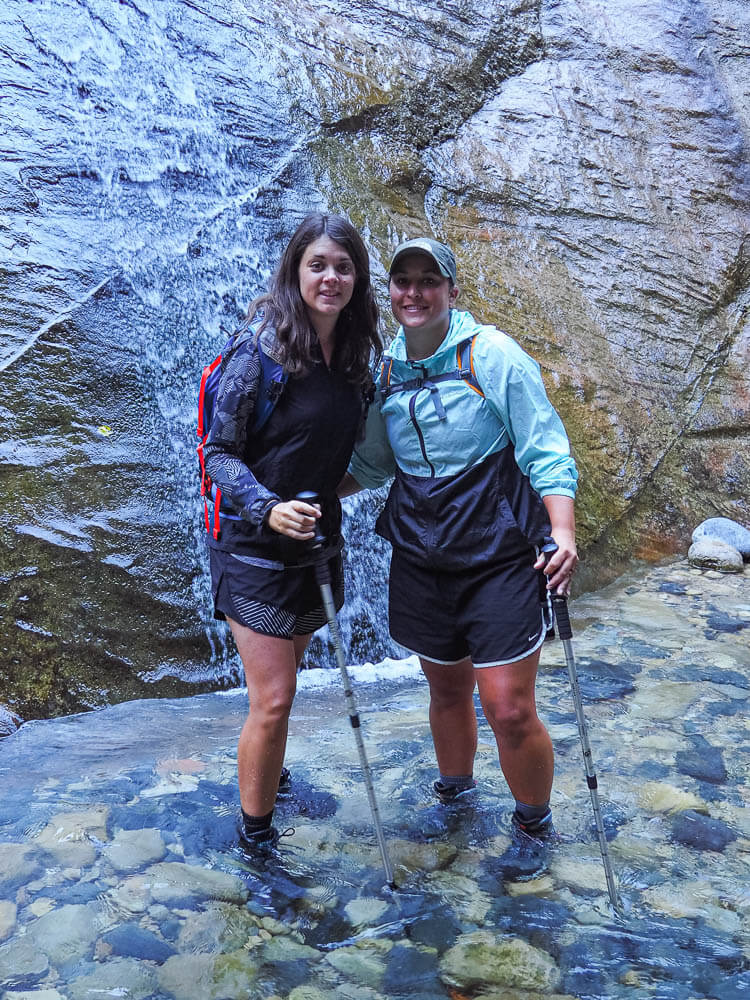
Some trails will be so special that they might require some additional hiking supplies to pack for day hikes. Make sure to browse through this list of gears for hiking not to forget these useful essentials for a hike on your next adventure.
Binoculars
If you don’t want to miss out on seeing wildlife up close but from a respectable and safe distance, make sure to include a travel pair of binoculars on your day hiking packing list. A simple compact pair of binoculars will be perfect for enjoying your wildlife viewing opportunities to the fullest.
Waist Pack
What to bring hiking when you only want some small essentials for a hike and you don’t like the bulkiness of a hikers pack? Try a waist pack instead. There are a ton of different styles, sizes, and designs that make finding the perfect one to pack for a hike a breeze.
Most of the time, we will bring one backpack and one waist pack on our hikes. We like to utilize a waist pouch to have quick access to our phones, tissues, and chapsticks along the trails.
Trekking Poles
To add trekking poles to your hiking list of gear is extremely useful. Trekking poles are most important for specific trail conditions, especially for steeper hikes, slippery winter hikes, or water-filled slot canyon hikes. They help you maintain your stability while trekking through tough sections. Plus, they help take some weight off your knees which is great for those difficult climbs or descends.
We only use our trekking poles a couple of times during the year but when we take them, we absolutely love their functionality. Your best bet is to buy foldable, lightweight ones which can easily be clipped on your hikers pack when you don’t need them.
Powerbank
We are sure you already know how fast phone batteries can die. But guess what, when you are out on the trails with limited to no service, it dies even faster.
When it comes to packing for a day hike, it is a no-brainer for us to carry a powerbank charger with us. Then we don’t have to worry about running out of batteries while navigating on the trails with our downloaded offline AllTrails hiking map.
Solar Battery Pack
An alternative option for what to bring on a hike to charge your phone is a solar battery pack. We like to bring a solar battery pack with us when we take overnight hiking backpacking trips when we need to charge a lot of our gadgets. This device is perfect because you can easily clip it on your hikers pack when hiking and it will be charged at the end.
Dry Bag
Carrying a dry bag is great for keeping your electronic gadgets dry, especially in rainy conditions or hikes with water obstacles. A basic dry bag on your day hike pack list should do the trick for pretty much all hikes.
Hammock
If you plan on hanging around and enjoying the view on your hike, we would recommend a hammock to pack for day hikes. There are a lot of lightweight hammocks which won’t take up a lot of space in your hikers pack.
We personally do not bring a hammock with us on a regular day hike. But we would pack one for an overnight hiking trip to lounge around in.
Trowel & Toilet Paper
Don’t know what to take hiking to properly dispose of your human waste? A must-have on your checklist for hiking is a trowel. You never know when you will have to do your business in nature. But when that time comes, you will want to be prepared especially if you find yourself in the middle of the woods.
Exposing your waste properly is another part of practicing Leave No Trace. To do so, one of the things to bring on a hike should be a compact trowel to dig a 6-8 inches deep hole, which should be the size of the trowel blade, and 4 to 6 inches in diameter. Then you bury your human waste in there.
Oh, and you don’t want to forget about toilet paper. For proper disposal, put it in your trash bag.
FAQs: Packing for a Hike
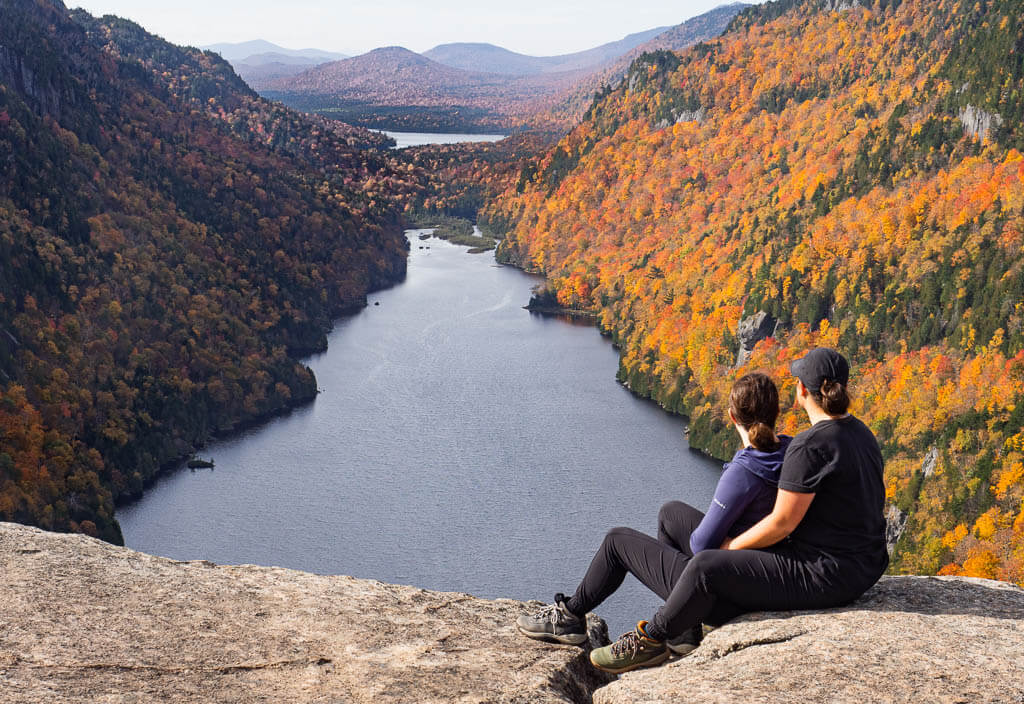
How can I find a cool day hike close to me?
One of the easiest ways to find a day hike near you is by using a hiking app. AllTrails is an easy-to-use app that provides a quick synopsis of the trail with the difficulty, length, elevation, type of hike, location, and trail map to follow.
We use AllTrails for every hike we take. Our favorite feature is the downloadable follow along with hiking trail map. Do note this feature is only available with the paid pro version.
Other ways to find interesting day hikes in your area are to quickly search the internet and read blog posts about the best hiking in a certain area.
How do I choose the right hike gear?
To choose the right equipment for hiking, you first need to know which hike you plan to do. Hikes in different areas on different terrain may require other types of hike gear.
Read our packing for a hike list to find the most important essentials for hikers and specific hiking supplies.
When you are ready to purchase essentials for hikers, take the time to read product reviews. Invest the time and money to find the right day hike gear for you.
How do you pack daypacks for hiking?
The key to packing for a day hike is weight distribution. You will want to ensure the weight in your hikers bag is evenly spaced on both sides to maximize comfort when wearing the backpack.
It is best to pack the heaviest items on the bottom portion of the bag closest to your back. You will want to add the lighter hiking equipment on top. This way, you carry the weight on your hips rather than your shoulders.
What should I be packing for a day hike?
When it comes to packing for hiking, you should bring the 10 hiking list essentials we talked about earlier, as well as any other necessary hiking supplies for the specific day hike you are taking.
What to pack for hiking always depends on the terrain and the weather conditions but for the majority of your hikes, your hiking list of gear will look the same. Pack only what you need and leave the rest at home.
What do I do when you see a dangerous animal?
Be prepared on how to handle animal encounters before heading out on any hike. It is best to be familiar with the animals that inhabit the area you are hiking in.
One of the easiest things to do to avoid these unwanted encounters is to be a noisy hiker. In Alaska, hikers tend to hang bells from their hikers packs to constantly make a noise. Talking is a great way to keep animals away too.
What to do when you get closer to an animal than expected, is dependent on which animal you encounter. When you see a wolf or bear, it is best to stop, slowly back away, and make yourself look as big as possible. When you find yourself eye to eye with a moose it is better to run away from the animal.
How do you deal with inclement weather on a day hike?
Prepare yourself before you start your hike. Make sure you know the possible weather conditions ahead of time and make sure to know what to pack for a day hike.
Of course, the weather can always be unpredictable, especially in the mountains. During your day hike keep an eye on the weather and know your limitations.
What to take on a hike as a beginner?
If you are a beginner hiker, what to take hiking is a comfortable hikers pack, proper hiking footwear, quality hiking socks, and the 10 hiking list essentials above.
Unfortunately, purchasing quality equipment for hiking can be quite expensive. Start with the basics and treat yourself to some new equipment once in a while. It took us a while until we got all of our beloved equipment for hiking.
What are the 10 hiking list essentials for survival?
The 10 hiking list essentials for survival are navigation, illumination, sun protection, first aid kit, repair kit and multi-tool, fire starter, emergency shelter, extra food, extra water, extra clothing.
These hiking supplies are the basics when it comes to packing for a hike. Depending on the type of hike, length, condition, and other factors you might want to consider bringing additional hiking supplies.
What should you not take on a hike?
If possible, you should not bring anything of value on your hike, as there is a chance for it to get lost or damaged. We always carry our wallets with us though to have some money in case of an emergency and to identify ourselves.
We would also suggest not wearing anything which you don’t want to get dirty since you will most likely get a little debris and sweat on your clothes
Basically, avoid bringing anything extra that is heavy and not on the essential day hike packing list.
What should I wear for a day hike?
You should wear comfortable and appropriate hiking clothes for your specific day hike. There are tons of quality hiking clothes to choose from. But the absolute most important thing to wear is proper hiking footwear. Tired and angry feet do not make for an enjoyable hike.
To keep it simple, look at these notes what to wear in different temperatures:
- Hot Weather – loose, breathable, and lightweight clothing
- Cold Weather – warm, insulated, and waterproof clothing
Which essentials for hiking do you always carry with you? How does your packing for a hike list look like?
Let us know in the comments below!
Our Other Hiking Resources:
- 15 Most Helpful Hiking Apps to Download
- 100+ Best Hiking Quotes to Inspire Your Future Adventures
- 100+ Best Gifts for Hikers to Buy
- 50 Best Gifts for Outdoorsy Women Created by Outdoor Lovers
You Might Also Like:
- New York: 33 Most Beautiful Trails for Hiking in Hudson Valley
- New York: 34 Top Rated Best Hikes Upstate New York
- New York: The Ultimate Guide to 11 Best Cold Spring Hiking Trails
- Sedona: 19 Can’t Miss Hikes in Sedona
- Quotes: 100+ Best Hiking Quotes to Inspire Your Future Adventures
- National Parks: 34 West Coast National Parks + Western U.S. Parks that Will Blow Your Mind
- National Parks: 16 Best East Coast National Parks You Need to Visit
Save this Post for later on Pinterest!
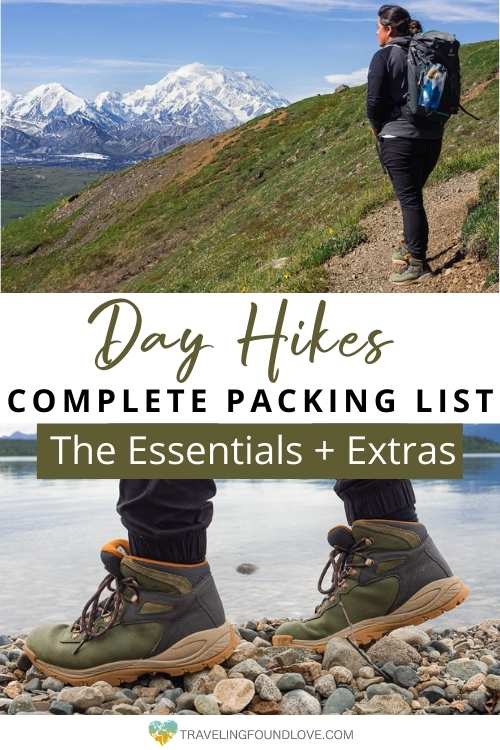
Did you like this post? Subscribe to our newsletter and we’ll send you more unique travel tips, updates, and even FREE content!


